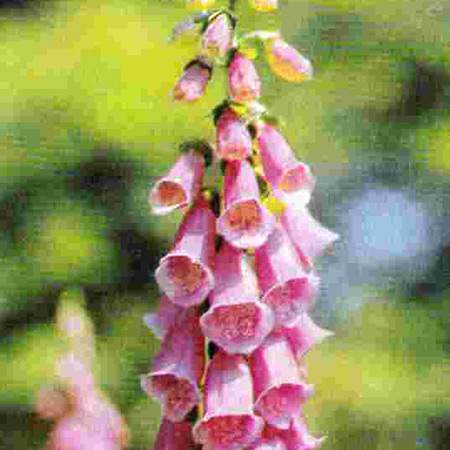Botanical name
Digitalis purpurea L.
Family
Plantaginaceae
Common name
Foxglove, Lady’s glove, Purple foxglove, Fairy gloves
Information about the plant
Foxglove is a poisonous plant native to Europe (!) and is particularly common on the west coast of Norway, in Great Britain, Germany, the Atlantic and sub-Atlantic regions of France, Belgium, and the Netherlands, as well as in the Pyrenees and the Atlantic parts of the Iberian Peninsula. It has also been introduced to the American continent, including Chile and Argentina. Foxglove grows in semi-shaded clearings, forest clearings, and bushy slopes.
The name ‘Fingerhut’ in German is derived from the flower’s shape, which resembles a thimble. This is also reflected in the Latin genus name Digitalis, which goes back to the Middle Latin ‘digitale’, which refers to the thimble as a tailor's tool. The species epithet purpurea refers to the purple color of the flower.
Foxglove is a biennial plant. During the first year, it forms a rosette of leaves lying on the ground; in the second year, a flower-bearing stem up to 2 meters high grows from the center. The leaves, both in the rosette and on the stem, are downy on the upper side and greyish tomentose on the underside; the lower leaves have long stalks, becoming increasingly stalkless towards the top. Numerous flowers are nodding on supporting leaves on the upper part of the stem in a loose, one-sided raceme, each in a small, pointed calyx. The purple-colored flower is tubular bell-shaped, 4 to 5 cm long, with a short upper lip and a longer, three-lobed lower lip. Dark, light-colored spots can be seen inside the lower lip. This is the flower's way of feigning ‘pollen abundance’ to attract bees to pollinate it. The fruit is an egg-shaped and hairy capsule enclosed in a calyx. Flowering occurs during June and July.
Medicinally used parts of plants (herbal drug)
The dried leaves (Digitalis purpurea leaves - Digitalis purpureae folium) are used, whereby the rosette leaves of the first year are usually harvested in early fall for economic reasons.
The commercially available drug comes from cultivations in the Balkan countries, Austria, and Switzerland.
Constituents of the herbal drug
D. purpurea leaves (foxglove leaves) contain numerous heart-active steroids in the form of cardenolides (cardenolide glycosides). The most important of which are purpurea glycosides A, B, and E with the aglycones digitoxigenin, gitoxigenin and gitaloxigenin. Steroid saponins and pregnane glycosides are also present. The cardenolides are responsible for the toxicity of the plant.
Quality of the drug
The quality of D. purpurea leaves (Digitalis purpureae folium) is specified in the European Pharmacopoeia (Ph. Eur.). The quality of the standardized Digitalis purpurea powder was specified in the German Pharmacopoeia (DAB) until 2014. The European Pharmacopoeia also contains a quality specification for “Digitalis for homeopathic preparations.”
Medical applications
Recognised medical use
In the past, foxglove leaves were used in folk medicine for cardiac insufficiency. However, due to the narrow therapeutic range (strong toxic effect of the cardenolides!), they should no longer be used in medical practice. D. purpurea leaves and the cardenolides isolated from them are highly potent remedies that must not be used phytotherapeutically. Therefore, D. purpurea leaves have not been evaluated by the HMPC and the ESCOP.
Traditional use
Due to the content of strongly cardioactive cardenolides, which are also responsible for the toxicity of the plant, D. purpurea leaves cannot be classified as a traditional herbal medicinal product (Article 16a of Directive 2001/83/EC).
Herbal drug preparations in finished dosage forms
Only finished medicinal products containing isolated cardenolides are commercially available and can only be used on medical prescriptions in individualized doses.
Dosage
Not applicable.
Preparation of a tea
Not applicable.
Notes
The leaves of D. purpurea are poisonous (strong cardiac effect!). Therefore, the drug or the finished medicinal product should only be used under medical supervision.



